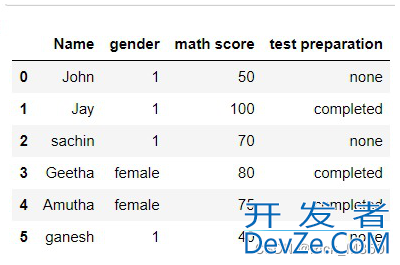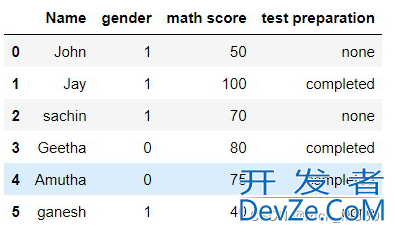目录
- 方法1:使用dataframe.loc[]函数
- 方法2:使用NumPy.where()函数
- 方法3:使用pandas掩码函数
- 方法4:替换包含指定字符的字符串
方法1:使用dataframe.loc[]函数
通过这个方法,我们可以用一个条件或一个布尔数组来访问一组行或列。如果我们可以访问它,我们也可以操作它的值,是的!这是我们的第一个方法,通过pandas中的dataframe.loc[]函数,我们可以访问一个列并通过一个条件改变它的值。
语法:df.loc[ df["column_name"开发者_JAVA入门] == "some_value", "column_name" ] = "value"
some_value = 需要被替换的值 value = 应该被放置的值。
示例: 我们要把性别栏中的所有 “男性 “改为1。
import pandas as pd
import numpy as np
# data
data= {
'Name': ['John', 'Jay', 'sachin', 'Geetha', 'Amutha', 'ganesh'],
'gender': ['male', 'male', 'male', 'female', 'female', 'male'],
'math score': [50, 100, 70, 80, 75, 40],
'test preparation': ['none', 'completed', 'none', 'completed',
'completed', 'none'],
}
# 创建一个 Dataframe 对象
df = pd.DataFrame(data)
# 条件应用
df.loc[df["gender"] == "male", "gender"] = 1
输出:

使用dataframe.loc[]函数
方法2:使用NumPy.where()函数
NumPy是一个非常流行的库,用于2D和3D数组的计算。它为我们提供了一个非常有用的方法where()来访问有条件的特定行或列。我们也可以用这个函数来改变某一列的特定值。 语法: df[“column_name”] = np.where(df[“column_name”]==”some_value”, value_if_true, value_if_false)
示例: 这个nphpumpy.where()函数应该写上条件,如果条件为真,后面是值,如果条件为假,则是一个值。现在,我们要把性别栏中的所有 “女性 “改为0,”男性 “改为1。
import pandas as pd
import numpy as np
# data
data= {
'Name': ['John', 'Jay', 'sachin', 'Geetha', 'Amutha', 'ganesh'],
'gender': ['male', 'male', 'male', 'female', 'female', 'male'],
'math sandroidcore': [50, 100, 70, 80, 75, 40],
'test preparation': ['none', 'completed', 'none', 'completed',
'completed', 'none'],
}
# 创建一个 Dataframe 对象
df = pd.DataFrame(data)
# 条件应用
df["gender"] = np.where(df["gender"] == "female", 0, 1)
输出:

使用NumPy.where()函数
方法3:使用pandas掩码函数
Pandas的掩蔽函数是为了用一个条件替换任何行或列的值。
语法: df[‘column_name’].mask( df[‘column_name’] == ‘some_value’, value , inplace=True )
示例:使用这个屏蔽条件,将性别栏中所有的 “女性 “改为0。
import pandas as pd
import numpy as np
# data
data= {
'Name': ['John', 'Jay'android, 'sachin', 'Geetha', 'Amutha', 'ganesh'],
'gender': ['male', 'male', 'male', 'female', 'female', 'male'],
'math score': [50, 100, 70, 80, 75, 40],
'test preparation': ['none', 'completed', 'none', 'completed',
'completed', 'none'],
}
# 创建一个 Dataframe 对象
df = pd.DataFrame(data)
# 条件应用 1
df['gender'].mask(df['gender'] == 'f编程客栈emale', 0, inplace=True)
# 条件应用 2
#df['math score'].mask(df['math score'] >=60 ,'good', inplace=True)
输出:

使用pandas掩码函数
方法4:替换包含指定字符的字符串
语法 : data["列名"].mask(data.列名.str.contains(".*?某字符串"), "替换目标字符编程串", inplace=True)
import pandas as pd
import numpy as np
# data
data= {
'Name': ['John', 'Jay', 'sachin', 'Geetha', 'Amutha', 'ganesh'],
'gender': ['male', 'male', 'male', 'female', 'female', 'male'],
'math score': [50, 100, '良70', 80, '良75', 40],
'test preparation': ['none', 'completed', 'none', 'completed',
'completed', 'none'],
}
# 创建一个 Dataframe 对象
df = pd.DataFrame(data)
# 条件应用
data["math score"].mask(data.math score.str.contains(".*?良"), "良好", inplace=True)

使用pandas掩码函数
到此这篇关于Pandas中根据条件替换列中的值的四种方式的文章就介绍到这了,更多相关Pandas 条件替换列值内容请搜索我们以前的文章或继续浏览下面的相关文章希望大家以后多多支持我们!









 加载中,请稍侯......
加载中,请稍侯......
精彩评论